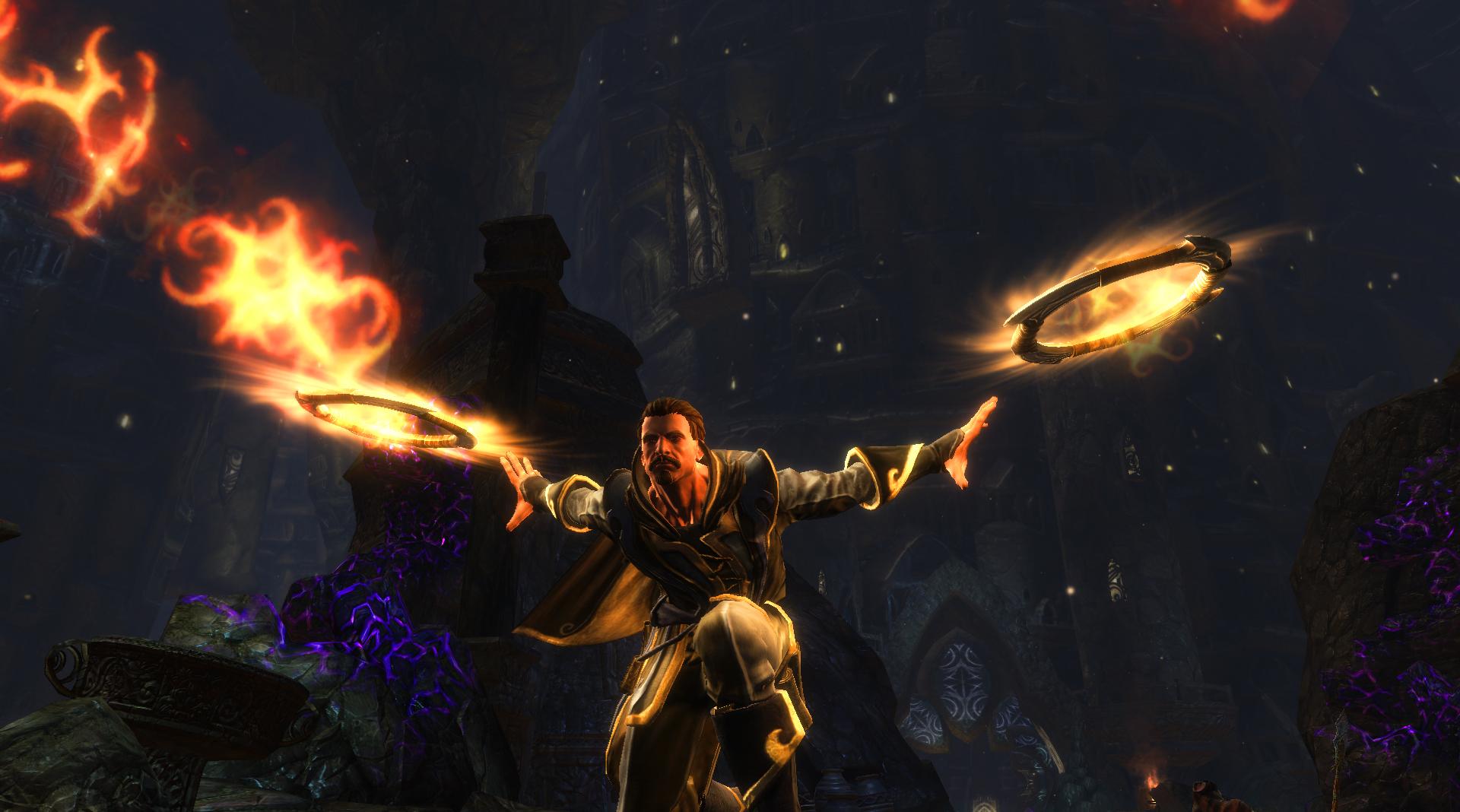Why you can trust GamesRadar+
Predestined to beat people up
Thankfully, even the most monotonous quests were made enjoyable thanks to Reckoning’s combat, which is leaps and bounds beyond what the genre normally presents. Action RPGs often drop the ball when it actually comes to the “action” part. It’s understandable – trying to wrap a deep RPG system into a fast-paced game is hard, and it’s much easier to simply create a turn-based game that feels action oriented than to actually make it a true action game. Reckoning doesn’t succumb to this, instead presenting combat that’s more akin to God of War’s than a traditional RPG. We’d dart around the battlefield, rolling from place to place and using multiple weapons and magical abilities in every battle, and when we faced bosses, they were massive, climactic experiences.
Above: Learn about the combat and see how fast and frantic it can be
Each weapon feels different, and every class gets access to a number of magical abilities, making combat continuously interesting. As a Warrior we’d throw a magical harpoon towards an enemy to pull them in close, bash them back away with a hammer, and then switch to our bow to finish off the enemy from afar. Larger enemies we’d need to block and roll around to fight, while we’d use a different strategy entirely for large group battles. It always felt fun, and it always felt fresh.
Beyond being action-packed, it’s also fairly tactical. Blocking isn’t instantaneous, and can’t be used mid-attack. This means running into every battle and spamming attacks spells doom. It’s still not as realistic as complex as a game like Dark Souls, which treats combat as realistic as possible, but it’s definitely more careful than a game like God of War.

Above: Throwing chakrams is so fun and so deadly
That changes when we initiate Reckoning mode, which is tied to a Fate meter that builds up as we fight. In this mode we do significantly enhanced damage and the enemies move slower, letting us make quick work of even the largest groups of foes. We can finish it off with a final move on one of the enemies, which executes a cinematic kill that lets us pound on the controller’s buttons to get extra experience. The different executions are beautifully brutal, and reward us for picking which battles we want to use them in to get the most experience.
Staying (multi)classy
And that was when we focused specifically on the Warrior branch of the class tree. There are three different class trees to work with: Warrior, Finesse, and Mage, each with a full line-up worth of skills. But you’re not forced into any one of these – in fact, the game rewards players that dabble in two or all of the skill trees.

Above: Here we see a ninja kill the guy from The Witcher
Different Destiny cards are unlocked once different point prerequisites are met, with certain abilities coming specifically to multiclassed characters. Our Mage/Warrior hybrid gained enhanced damage, a magical shield, and the ability to teleport around the battlefield after putting enough points into each skill tree. It’s a great incentive to try new things, and we found that we favored multiclass builds over playing the game too straight – by mixing things up, our longsword-wielding Battle Mage could teleport behind enemies, charge up a chakram throw, and then unleash it to decimate enemies with spinning blades. We could also tie in Finesse to add in some stealth damage, giving our triple-classed character amazing burst damage out of stealth.
What’s more, the game does a good job of differentiating between “Skills” and “Abilities.” Crafting, persuasion, stealth, and detecting hidden loot caches are all Abilities, drawing from a different pool than the other Skills, and we’re awarded points to spend in both at each level. This might seem minor, but it means we’re able to fully enjoy all of the elements of the game without completely locking ourselves into them. We never had to choose if we wanted to learn a cool new fireball spell or gain the ability to pick locks better, and we’re happy the game never made us make that choice. And if we ever decided we didn’t like the skills we chose, we could just get them reset by a Fateweaver, who would return us to a clean slate again.
Above: Discover how the crafting and skill systems work together
The only issue we ended up having with the game’s skills was that crafting, in general, wasn’t as rewarding as we would have liked. Loot is important in Reckoning, and finding a new Set helmet or rare sword is something to get excited about. Creating awesome items simply takes away from the experience. We found that we’d constantly be disappointed with whatever awesome new sword the boss dropped, because it was either worse than the one we had, which is annoying, or because it was better than the one we'd spent so much time crafting. It’s lose-lose, and we were happy to be able to go to a Fateweaver to drop crafting entirely in favor of pumping up persuasion and other abilities.
More info
| Genre | Role Playing |
| Platform | "Xbox 360","PC","PS3" |
Hollander Cooper was the Lead Features Editor of GamesRadar+ between 2011 and 2014. After that lengthy stint managing GR's editorial calendar he moved behind the curtain and into the video game industry itself, working as social media manager for EA and as a communications lead at Riot Games. Hollander is currently stationed at Apple as an organic social lead for the App Store and Apple Arcade.




